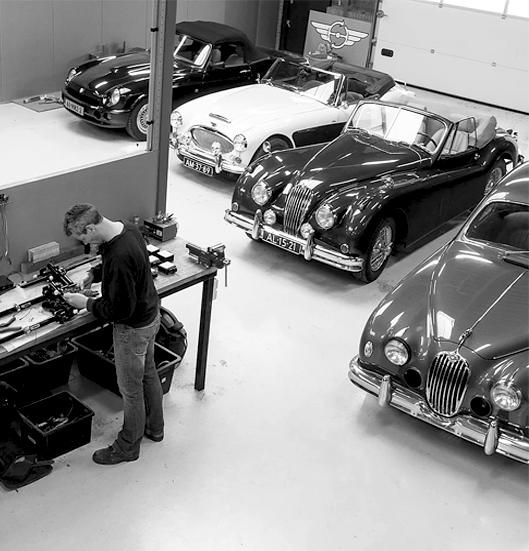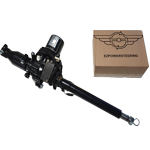- Home
- Car Brands
BRANDS
Select the car brand below for which you would like to see our products.
- Products
- Publications
- Testimonials
- FAQ
- Enquiry form
- Contact
Frequently Asked Questions
Please read the installation manual carefully before installation. Compare the EZ POWER STEERING column with the original column. Check that the dimensions are the same. Also mount the steering wheel on the column. If you do not have the skills or tools to perform the installation, have a professional do it. The steering gear should always be properly aligned and tension-free. Never strike the input shaft with an object during or after assembly. This can adversely affect the sensors. The basic EZ kit is a 12V system with negative ground! Additional wiring kits are available so that the kit also works with a 6V or 24V system and/or positive ground. Check the configuration of your vehicle before installing the EZ unit. Please note that EZ POWER STEERING cannot be held liable for improper installation or self-inflicted damage.
Our EZ Electric power steering kits are designed specifically for your car make and model. It has several advantages, including:
- The kit is completely hidden under the dashboard.
- The existing steering rack or box remains unchanged and thus retains the standard steering ratio and adjustment.
- Because the electric power steering is really speed sensitive, it will steer lightly at low speeds and not lightly at high speeds.
- The electric motor uses power only when steering assistance is needed, while a hydraulic pump operates continuously when the engine is running.
- The EZ electric power steering works without making any noise.
The EZ electric power steering kit cannot leak, making it completely maintenance free!
In this case, it is first necessary to find out whether the fault is mechanical or electrical.
This can be checked relatively easily by removing the electric power steering fuse. This ensures that the system is switched off. As a result, the car will have to drive the same as before the installation of the EZ steering column.
If you still have the same complaints during this test drive, then the fault is mechanical in nature and the steering column installation should be checked again. Is the alignment of the steering column itself in order and are no parts mounted under tension (see installation manual)
If it turns out that it is not a mechanical failure then it is important to collect as much data (measurements) as possible. To do so, use the measurement form in our troubleshooting guide.
Click on the link opposite to open the manual: EZ Handleiding voor probleemoplossing V6.0
This data is also important when you contact EZ, with this data we can find out in a relatively short time what is causing the failure and be able to offer you an appropriate solution.
EZ Powersteering manufactures more than 200 different power steering kits that are all customized for various classic cars. Our goal is always to design these kits with the utmost respect for originality. In some cases, the available space around the upper steering column is extremely limited and we must find a power steering unit compact enough to be mounted out of sight, usually under the dash. The length and shape of the unit and its power determine whether or not it can be used for certain classic car applications.
Over the past 15 years, we have used more than 22 different types of electric power steering units, mainly from Japanese manufacturers Koyo/JTEKT and NSK. In some cases, the power steering units have been discontinued. When they are no longer available new and we need to produce kits designed with these components, we buy used units and overhaul them ourselves (this is not much different from the new units we buy, which we also disassemble to make the torsion bar suitable for our application, at the same time reducing internal friction to achieve better self-centering and steering feel).
This means that in some cases remanufactured power steering systems are used to produce some of the kits we sell, as new systems with similar specifications are not available. If, at a later date, a power steering kit comes into production with similar dimensions and performance to the previously used component, the power steering kit for a given car can be redesigned to use the new type.
We regularly get requests for rally cars. The steering of these cars are subjected to extreme stress. To this, of course, we adapted our EZ power steering. For this niche market, we have developed additional adjustment capabilities with integrated cooling for the electric motor and control unit.
We are proud to announce that one of our last ‘obstacles’ has also been overcome: power steering for pre-war vehicles while retaining all steering functions.
In many pre-war vehicles, mechanical controls (for throttle, pre-ignition, damping, lighting or the fuel mixture, among others) run through the steering shaft. These functions are controlled by a “stator tube” that keeps the controls stationary while the steering wheel turns. In this stator tube, often even three other tubes rotate together for the other controls.
To build electric power steering into the column, we need a column with a hollow shaft. Therefore, it was necessary to develop a new system. By the way, this is applicable not only to prewar models, but also to younger cars with a hollow steering shaft.
The system can be supplied as a kit with adapters that allow the unit to be mounted in the original steering column. We supply a complete replacement column for various models. In most cases, it is possible to restore the original steering gear to its original condition. The steering box must obviously be in good condition for conversion to electric power steering. We check if this is the case, and if necessary, we also offer an overhaul service.
Currently, we have already equipped over 130 vehicles with this new pre-war system. Among these are Vintage and Derby Bentley models, the Rolls Royce Phantom, the Cadillac V16, Packards, Cords, Lagondas, the Alvis Speed 20 and 25 and the Mercedes 540 K.
Click on the link to the right for more information: Pre-War information_version_1.0_UK
We prefer to call it “load-sensitive” rather than “speed-sensitive.”
All of our kits are load sensitive, as are most hydraulic systems. This means that at low speed, the steering wheel is heavy and the torsion bar has maximum twist. The torque sensor senses this twist and therefore the ECU calculates the maximum assistance. As you drive faster, the steering gets lighter, so the torsion bar twists less and the ECU calculates less support.
The pulse generator is an additional feature and not always necessary or an improvement. If the kit is equipped with a wiring harness with a potentiometer, the system uses a simulated speed signal that can be adjusted manually. Turning the knob counterclockwise creates a low simulated speed signal resulting in maximum support.
In some cases, it is also possible to connect the ECU with an electronic speed pulse, but keep in mind that this may not necessarily improve “steering feedback” (e.g. car sensitivity and steering feel).
For an electric speed pulse we have a different wiring harness, but it is also possible to convert the wiring harness with a potentiometer to a wiring harness with electronic speed pulse.
The blue wire from the controller to the ECU must be cut and the speed pulse must go through the blue wire to the ECU. See here for instructions:EZ installation speedsensor UK (version 1.0 – 2024)
However, it is also possible to convert an electronic speed pulse wiring harness to a potentiometer wiring harness. See here for instructions:EZ installation potentiometer UK (version 1.0 – 2024)
Orders from New Zealand are only available on request and cannot be placed directly through our web shop.
EZ Powersteering has been supplying power steering kits to customers in New Zealand for over 15 years. We’re proud to have many satisfied classic car owners in your beautiful country who enjoy driving their cars with our systems installed.
Recently, we’ve been informed that New Zealand authorities have begun conducting more thorough inspections during the MOT process, particularly focusing on any non-original components. Their goal is to ensure that modified vehicles remain safe for road use.
One aspect of the inspection process is the presence of welds in the steering column. While this is common and acceptable in many original classic cars, in New Zeeland non-OEM manufacturers are generally not permitted to use welded joints. EZ Powersteering primarily uses splined or pinned connections. In rare cases where welding is involved, it is always performed by one of our certified welders.
We want to assure you that our systems are safe. In the past, we have worked closely with New Zealand vehicle inspectors—for example, we provided extensive production documentation. This included step-by-step photographs of the production process, clearly showing the VIN number of the vehicle on each image. Authorities may now require this level of documentation even for standard classic cars.
If needed, we can custom-made a power steering kit with full documentation and photographic evidence showing that no welds are present. However, please note that such a request will increase the cost and delivery time, as the kit must be specially and individually produced and documented for the specific vehicle.
We still have many customers in New Zealand using our standard EZ Powersteering systems without any issues. Ultimately, the choice is yours depending on your local registration needs.
To summarize:
- Orders from New Zealand must be placed by request.
- Our products are not available through the web shop for New Zealand customers.
- If needed, we can produce a fully documented, weld-free version of the kit—on request. Please note that such a request will increase the cost and delivery time, as the kit must be specially and individually produced and documented for the specific vehicle.
Please feel free to contact us if you have any questions or need further assistance.
- Home
- Car Brands
BRANDS
Select the car brand below for which you would like to see our products.
- Products
- Publications
- Testimonials
- FAQ
- Enquiry form
- Contact





